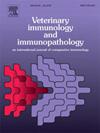Waste milk consumption in dairy calves: Effects on innate immunity and inflammatory profile
IF 1.4
3区 农林科学
Q4 IMMUNOLOGY
引用次数: 0
Abstract
Waste milk (WM) is commonly used in calf feeding to reduce rearing costs; however, its effects on the innate immune response remain unexplored. Therefore, this study aimed to evaluate the effects of WM on the innate immune response and inflammatory profile of pre-weaned dairy calves. Thirty male Holstein calves were assigned to receive pasteurized waste milk (PWM), saleable milk (SM), and WM (n = 10 in each group). Blood samples were collected on D7, D21, D35, D49, and D63 (days of life) to assess the white blood cell (WBC) count, phagocytic activity of polymorphonuclear cells (PMN), and nitric oxide (NO) production by monocyte-derived macrophages, in addition to the measurement of oxidative stress biomarkers and haptoglobin concentration. A trend towards a higher occurrence of respiratory disease was detected in calves that received WM, followed by PWM. A group effect (P = 0.00) was observed in absolute monocyte values, with higher values found in the WM group. Only the TBARS concentration showed a group × time interaction among all oxidative stress biomarkers, with the highest mean found in calves receiving WM, followed by those receiving PWM and SM. Elevated TBARS concentrations indicated higher lipid peroxidation, which may have resulted from the accumulation of reactive oxygen species (ROS) due to immune challenges from ingesting pathogens present in WM. Haptoglobin concentration was unaffected. WM promoted lipid peroxidation and antioxidant enzyme activity, suggesting a pro-inflammatory effect. The time-effects of PMN phagocytosis reflected the development of the immune system in neonatal calves, which is consistent with previous studies.
犊牛废奶消耗:对先天免疫和炎症的影响。
废奶(WM)通常用于犊牛饲养,以降低饲养成本;然而,其对先天免疫反应的影响仍未被探索。因此,本研究旨在评估WM对断奶前犊牛先天免疫反应和炎症的影响。30头雄性荷斯坦犊牛分别接受巴氏杀菌废奶(PWM)、可售奶(SM)和WM (n = ,每组10头)。在D7、D21、D35、D49和D63(生命日)采集血样,评估白细胞(WBC)计数、多形核细胞(PMN)的吞噬活性和单核细胞来源的巨噬细胞产生一氧化氮(NO),以及测量氧化应激生物标志物和接触珠蛋白浓度。在接受WM的小牛中发现了更高的呼吸道疾病发生率的趋势,其次是PWM。在绝对单核细胞值上观察到组效应(P = 0.00),WM组的数值更高。只有TBARS浓度在所有氧化应激生物标志物之间表现出组× 时间相互作用,WM组的平均值最高,其次是PWM组和SM组。升高的TBARS浓度表明更高的脂质过氧化,这可能是由于摄入WM中存在的病原体引起的免疫挑战导致活性氧(ROS)积累所致。触珠蛋白浓度未受影响。WM促进脂质过氧化和抗氧化酶活性,提示促炎作用。PMN吞噬的时间效应反映了新生牛犊免疫系统的发育,这与前人的研究一致。
本文章由计算机程序翻译,如有差异,请以英文原文为准。
求助全文
约1分钟内获得全文
求助全文
来源期刊
CiteScore
3.40
自引率
5.60%
发文量
79
审稿时长
70 days
期刊介绍:
The journal reports basic, comparative and clinical immunology as they pertain to the animal species designated here: livestock, poultry, and fish species that are major food animals and companion animals such as cats, dogs, horses and camels, and wildlife species that act as reservoirs for food, companion or human infectious diseases, or as models for human disease.
Rodent models of infectious diseases that are of importance in the animal species indicated above,when the disease requires a level of containment that is not readily available for larger animal experimentation (ABSL3), will be considered. Papers on rabbits, lizards, guinea pigs, badgers, armadillos, elephants, antelope, and buffalo will be reviewed if the research advances our fundamental understanding of immunology, or if they act as a reservoir of infectious disease for the primary animal species designated above, or for humans. Manuscripts employing other species will be reviewed if justified as fitting into the categories above.
The following topics are appropriate: biology of cells and mechanisms of the immune system, immunochemistry, immunodeficiencies, immunodiagnosis, immunogenetics, immunopathology, immunology of infectious disease and tumors, immunoprophylaxis including vaccine development and delivery, immunological aspects of pregnancy including passive immunity, autoimmuity, neuroimmunology, and transplanatation immunology. Manuscripts that describe new genes and development of tools such as monoclonal antibodies are also of interest when part of a larger biological study. Studies employing extracts or constituents (plant extracts, feed additives or microbiome) must be sufficiently defined to be reproduced in other laboratories and also provide evidence for possible mechanisms and not simply show an effect on the immune system.

 求助内容:
求助内容: 应助结果提醒方式:
应助结果提醒方式:


